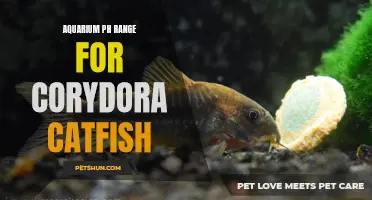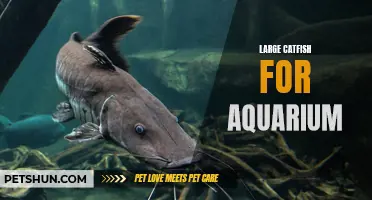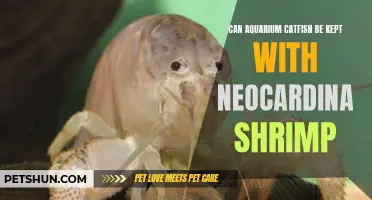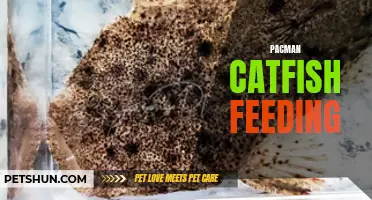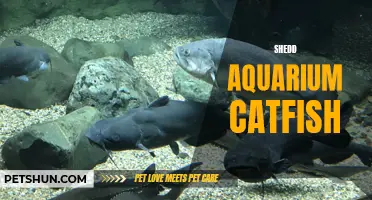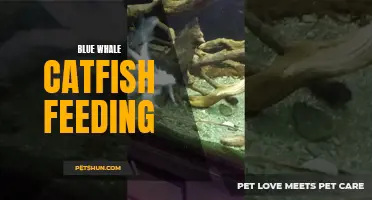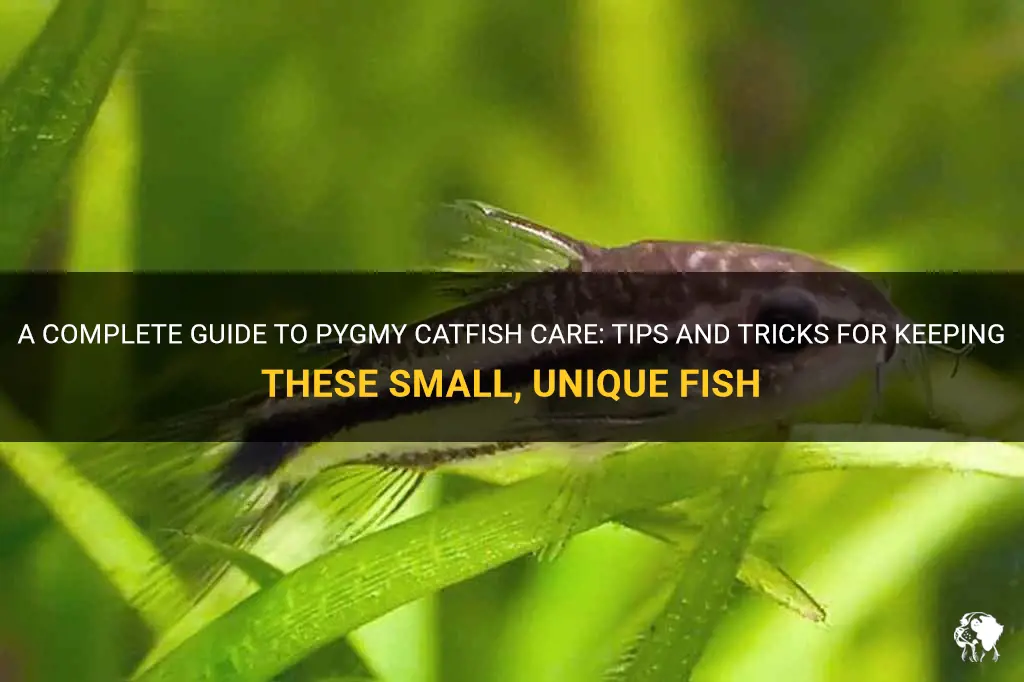
Are you a catfish enthusiast looking for a unique addition to your aquarium? Look no further than the pygmy catfish! These tiny and fascinating creatures are the perfect choice for any aquarium lover seeking an intriguing and low-maintenance pet. In this guide, we will explore the world of pygmy catfish care, as well as provide tips and tricks to ensure their happiness and well-being in your aquarium. Get ready to dive into the world of these pint-sized marvels and unlock the secrets to successful pygmy catfish care!
| Characteristics | Values |
|---|---|
| Scientific name | Corydoras pygmaeus |
| Common name | Pygmy catfish |
| Size | 1-1.5 inches |
| Lifespan | 3-5 years |
| Tank size | 10-15 gallons |
| Water parameters | pH 6.0-7.5, temperature 72-78°F |
| Diet | Omnivorous, prefers sinking pellets and live/frozen foods |
| Behavior | Peaceful, shoaling fish |
| Tank setup | Plenty of hiding places, live plants, sandy substrate |
| Care level | Easy |
| Compatibility | Suitable for community tanks with small peaceful fish |
| Breeding | Egglayer, prefer soft, acidic water for spawning |
| Special considerations | Require regular water changes and good filtration to maintain water quality |
What You'll Learn
- What type of water conditions do pygmy catfish prefer in their tank?
- How often should pygmy catfish be fed, and what kind of food do they require?
- Are pygmy catfish social creatures that should be kept in groups, or can they be kept alone?
- What is the ideal tank size for pygmy catfish, and what type of hiding spots should be provided for them?
- Do pygmy catfish have any specific health concerns or diseases that owners should be aware of?

What type of water conditions do pygmy catfish prefer in their tank?
Pygmy catfish, also known as Corydoras hastatus, are small freshwater fish that are popular among aquarium enthusiasts. They are native to South America and are known for their peaceful nature and their ability to help keep the tank clean by scavenging for food particles at the bottom of the tank. Like any other fish, pygmy catfish have specific water condition requirements to thrive in their tank.
Water temperature is an essential factor to consider when setting up a tank for pygmy catfish. These fish prefer a temperature range of 72-79°F (22-26°C). It is crucial to maintain a stable temperature as sudden fluctuations can stress the fish and make them more susceptible to diseases. Using a reliable aquarium heater with a thermostat can help maintain a consistent temperature.
Pygmy catfish also prefer slightly acidic water with a pH range of 6.5-7.5. They are adaptable and can tolerate a wide range of pH levels, but it is important to avoid extreme fluctuations. Regular testing of the water parameters using a reliable aquarium test kit will help ensure the pH remains within the desired range.
In terms of water hardness, pygmy catfish are comfortable in soft to moderately hard water. A hardness range of 5-15 dGH (degree of general hardness) is suitable for their tank. The hardness of water can be adjusted by adding commercial water conditioners or using specific types of substrate that can alter the water chemistry.
Another crucial consideration for pygmy catfish is the presence of good water filtration. These fish are sensitive to high levels of ammonia and nitrite, which can be harmful to their health. A high-quality filter that can efficiently remove waste particles and help maintain biological filtration by establishing beneficial bacteria colonies is essential. Regular water changes can also help keep the water quality optimal for the pygmy catfish.
It is important to note that pygmy catfish are shoaling fish, meaning they prefer to live in groups. Keeping them alone or in too small of a group can cause stress and potentially affect their health. A group of at least six pygmy catfish is recommended for their social well-being.
When introducing pygmy catfish to a new tank, it is advised to acclimate them slowly to their new environment. This can be done by floating their bag in the tank for about 15-20 minutes to allow the water temperature to equalize. Then, a small amount of tank water can be added to the bag every few minutes over the course of an hour. This gradual adjustment will help minimize stress and increase the chances of a successful transition.
In conclusion, pygmy catfish have specific water condition requirements to thrive in their tank. They prefer water temperatures between 72-79°F, a pH range of 6.5-7.5, and a hardness range of 5-15 dGH. Good water filtration and regular water changes are also crucial for their health. Additionally, it is recommended to keep pygmy catfish in groups of at least six for their social well-being. By providing the right water conditions and proper care, pygmy catfish can thrive and bring beauty to any aquarium.
The Ultimate Guide to Caring for Crystal Eyed Catfish
You may want to see also

How often should pygmy catfish be fed, and what kind of food do they require?
Pygmy catfish, also known as Corydoras pygmaeus, are a popular choice for aquarium enthusiasts due to their small size and peaceful nature. As with any fish, it is important to provide them with the proper diet and feeding schedule for optimal health and well-being.
Feeding Frequency:
When it comes to feeding pygmy catfish, a regular and consistent feeding schedule is key. These tiny fish have fast metabolisms and should be fed multiple times a day. It is recommended to feed them small amounts of food two to three times daily. This will keep their bellies full without overfeeding them and polluting the aquarium water.
Food Types:
Pygmy catfish are omnivorous, which means they can eat both plant and animal-based foods. In the wild, they primarily feed on small invertebrates and bottom-dwelling crustaceans. In captivity, they should be provided with a balanced diet that includes a mix of high-quality flake or pellet food, freeze-dried or frozen foods, and live foods.
Dry Foods:
High-quality flake or pellet foods formulated specifically for small bottom-dwelling fish are readily available in pet stores. These should make up the base of the pygmy catfish's diet. Look for products that contain a variety of protein sources such as fish meal, shrimp, and brine shrimp. These foods are nutritionally complete and provide the necessary vitamins and minerals for overall health.
Frozen and Freeze-dried Foods:
To add variety to their diet, pygmy catfish should also be offered frozen or freeze-dried foods. These can include bloodworms, daphnia, brine shrimp, and tubifex worms. These food options are rich in protein and replicate the type of prey they would hunt in the wild. Before feeding frozen foods, make sure to thaw them properly and rinse them in aquarium water to remove any excess preservatives or unwanted materials.
Live Foods:
Many pygmy catfish will readily accept live foods as part of their diet. Small live foods such as baby brine shrimp or micro worms are great options. These foods are high in protein and provide enrichment as the fish can exhibit natural foraging behaviors. Live foods can be obtained from specialized aquarium stores or even cultivated at home with the proper knowledge and equipment.
Feeding Techniques:
When feeding pygmy catfish, it is important to ensure the food is reaching the bottom of the tank where they forage. Pellets or flakes can be gently dropped near the bottom of the aquarium, while frozen or freeze-dried foods can be defrosted and added with a pipette or turkey baster. Live foods can be placed on the substrate or introduced through the use of a pipette.
In conclusion, pygmy catfish should be fed small amounts of food two to three times a day to accommodate their fast metabolism. They should be provided with a balanced diet that includes a mix of high-quality flake or pellet food, frozen or freeze-dried foods, and live foods. By following these guidelines, aquarists can ensure the health and vitality of their pygmy catfish.
The Essential Guide to Juruense Shovelnose Catfish Care
You may want to see also

Are pygmy catfish social creatures that should be kept in groups, or can they be kept alone?
Pygmy catfish, also known as Corydoras pygmaeus, are small freshwater fish that are native to South America. They are a popular choice for aquarium enthusiasts due to their unique appearance and peaceful nature. However, when it comes to keeping pygmy catfish, many people wonder whether they should be kept in groups or if they can be kept alone. In order to answer this question, it is necessary to understand the social nature of pygmy catfish and their natural behavior in the wild.
In their natural habitat, pygmy catfish are social creatures that live in large groups, often numbering in the hundreds. They are frequently found in the shallow, slow-moving waters of the Amazon rainforest, where they use their sensitive barbels to search for small organisms and detritus on the riverbed. The presence of other individuals provides protection from predators and allows for more efficient foraging. This social behavior has been well-documented in scientific studies and observations.
Given their social nature, it is generally recommended to keep pygmy catfish in groups rather than as solitary individuals. When kept alone, pygmy catfish may become stressed and exhibit abnormal behaviors. They may hide more frequently, lose their appetite, and become weaker over time. Additionally, when kept alone, pygmy catfish may not display their natural schooling behavior, which can be a visually pleasing sight in a well-kept aquarium.
The ideal group size for pygmy catfish is a minimum of six individuals. This allows them to engage in natural behaviors and create a sense of security. It is important to note that pygmy catfish are not aggressive towards each other and can coexist peacefully. In fact, they often display synchronized movements and schooling behavior, which adds to the aesthetic appeal of the aquarium.
When setting up an aquarium for pygmy catfish, it is essential to provide adequate space and hiding spots. These small fish appreciate a well-planted aquarium with plenty of hiding places such as caves, driftwood, and dense vegetation. This not only provides shelter but also mimics their natural habitat, helping them feel more comfortable and secure. A substrate of fine sand or smooth gravel is also recommended to prevent any injury to their delicate barbels.
Feeding pygmy catfish is relatively easy as they are omnivores and will accept a variety of foods. A balanced diet consisting of high-quality flake or pellet food supplemented with live or frozen foods such as bloodworms, daphnia, or brine shrimp is ideal. It is important to avoid overfeeding to maintain good water quality and prevent obesity.
In conclusion, pygmy catfish are social creatures that thrive in groups. Keeping them alone can lead to stress and unhealthy behaviors. Therefore, it is recommended to keep at least six pygmy catfish together in a well-planted aquarium with hiding spots and a varied diet. By providing the right environment and companionship, pygmy catfish can live happily and exhibit their natural social behavior in captivity.
The Complete Guide to Goonch Catfish Care: Tips and Advice
You may want to see also

What is the ideal tank size for pygmy catfish, and what type of hiding spots should be provided for them?
Pygmy catfish, also known as dwarf catfish or corydoras pygmaeus, are small freshwater fish native to South America. They are highly popular among aquarium enthusiasts due to their small size, peaceful demeanor, and intriguing behavior. If you plan on keeping pygmy catfish in your aquarium, it’s important to provide them with the right tank size and suitable hiding spots to ensure they thrive.
The ideal tank size for pygmy catfish depends on the number of fish you plan on keeping. These small catfish can reach a maximum size of around one inch. As a general rule of thumb, it’s recommended to provide at least 10 gallons of water per pair of pygmy catfish. This means that a small group of 6-8 individuals would require a tank size of around 20-30 gallons.
In addition to the tank size, it’s crucial to consider the water parameters for pygmy catfish. They prefer water temperatures between 72-78°F (22-26°C) and a pH range of 6.0-7.8. It’s important to keep the water clean and free from ammonia and nitrites, as these can be harmful to the catfish.
When it comes to creating hiding spots for pygmy catfish, it’s essential to recreate their natural habitat. In the wild, pygmy catfish live in rivers and streams with dense vegetation and plenty of hiding places. They use these hiding spots to take cover from predators and rest during the day.
To provide suitable hiding spots, you can include various elements in your aquarium setup. One popular option is to use live plants, such as Java moss or Anubias, which provide both hiding places and additional filtration for the tank. These plants can be attached to rocks or logs to create natural-looking hiding spots for the catfish.
You can also include artificial cave structures or PVC pipes in your tank to provide additional hiding spots. These can be placed strategically around the tank to create a maze-like environment, giving the catfish plenty of places to explore and hide.
It’s important to have multiple hiding spots distributed throughout the tank to ensure each pygmy catfish has its own space. This helps reduce stress and competition among the fish. By providing ample hiding spots, you’ll also be able to observe their natural behavior more easily, as they’ll feel more comfortable and secure in their environment.
When introducing pygmy catfish to your aquarium, it’s recommended to provide them with a few days to acclimate to their new surroundings. Dim the lights and keep the tank as quiet as possible during this time. This will help reduce stress and allow the catfish to adjust more easily.
In conclusion, the ideal tank size for pygmy catfish is at least 10 gallons per pair, with a larger tank recommended for larger groups. It’s important to recreate their natural habitat by providing suitable hiding spots, such as live plants, artificial caves, and PVC pipes. By providing the right tank size and hiding spots, you’ll create a comfortable and secure environment for your pygmy catfish to thrive in.
Caring for Honey Comb Catfish: A Complete Guide
You may want to see also

Do pygmy catfish have any specific health concerns or diseases that owners should be aware of?
Pygmy catfish, also known as Corydoras pygmaeus, are small freshwater fish that are popular among aquarium enthusiasts for their unique appearance and behavior. While these catfish are generally hardy and easy to care for, there are a few specific health concerns and diseases that owners should be aware of to ensure the well-being of their fish.
One common health concern for pygmy catfish is bacterial infections. These infections can be caused by a variety of factors, including poor water quality, stress, or injuries. Symptoms of a bacterial infection in pygmy catfish may include loss of appetite, lethargy, discolored or frayed fins, and sores or lesions on the fish's body. If you notice any of these symptoms, it is important to take action quickly to prevent the infection from spreading to other fish in the tank. Treating bacterial infections typically involves improving water quality, providing a stress-free environment, and using medications specifically designed to target bacterial pathogens.
Another health concern for pygmy catfish is parasitic infections. These can be caused by various types of parasites, including ich, flukes, and worms. Parasitic infections can cause symptoms such as excessive scratching or rubbing against objects in the tank, weight loss, loss of color, and abnormal behavior. If you suspect that your pygmy catfish has a parasitic infection, it is important to isolate the affected fish and treat them with an appropriate medication designed to target the specific parasite. It is also crucial to thoroughly clean the tank and quarantine any new fish to prevent the spread of parasites.
In addition to bacterial and parasitic infections, pygmy catfish are also susceptible to fungal infections. Fungal infections can occur when the fish's immune system is compromised or when there is a buildup of organic matter in the tank. Symptoms of a fungal infection may include a fuzzy or cotton-like growth on the fish's body or fins, loss of appetite, and lethargy. To treat fungal infections, it is important to maintain good water quality and provide a stress-free environment for the fish. Medications specifically designed to target fungal pathogens can also be used to help eliminate the infection.
Prevention is key when it comes to keeping pygmy catfish healthy. Providing a clean and well-maintained environment for your fish is crucial in preventing the development of health issues. Regular water changes, maintaining proper filtration, and avoiding overfeeding can help to prevent bacterial, parasitic, and fungal infections. It is also important to quarantine any new fish before introducing them to the tank to prevent the introduction of disease-causing organisms.
In conclusion, while pygmy catfish are generally hardy and easy to care for, there are specific health concerns and diseases that owners should be aware of. Bacterial, parasitic, and fungal infections can all affect the health of these fish, but with proper care and attention to water quality, these issues can be prevented or effectively treated. By providing a clean and stress-free environment for your pygmy catfish, you can help ensure their long-term health and well-being.
The Complete Guide to Indian Butterfly Catfish Care
You may want to see also
Frequently asked questions
Pygmy catfish are small fish and do not require a large tank. A tank size of at least 10 gallons is recommended for a small group of pygmy catfish. This will provide enough space for them to swim and explore without feeling cramped.
Pygmy catfish are omnivores and will eat a variety of foods. They will readily consume commercial fish foods such as flakes or pellets, but it is also important to supplement their diet with live or frozen foods. This can include small worms, brine shrimp, or daphnia. Offering a varied diet will help ensure that your pygmy catfish receive all the necessary nutrients.
Regular tank maintenance is important to ensure the health of your pygmy catfish. It is recommended to do a partial water change of 25-50% every 1-2 weeks. During these water changes, you can also siphon out any debris or waste that has accumulated on the bottom of the tank. Additionally, it is important to clean the filter regularly to ensure proper filtration and water quality.


